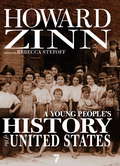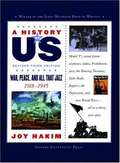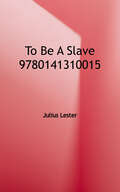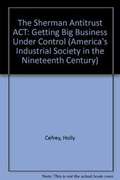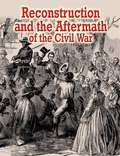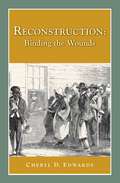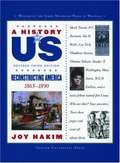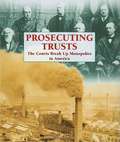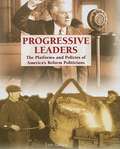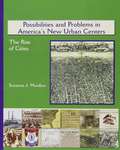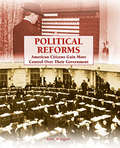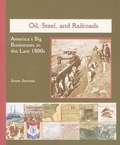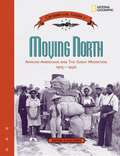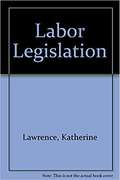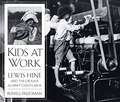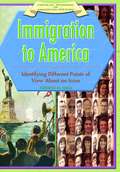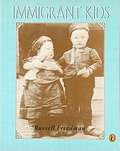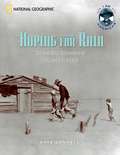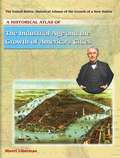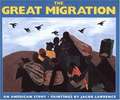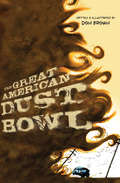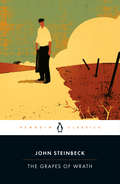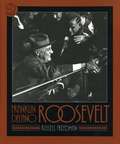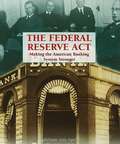Special Collections
District List: NYC Core Curriculum 8th - Social Studies
Description: The New York City Core Curriculum program aims to provide a high-quality curricula to NYC students through a seamless instructional program across grades and subjects. This list has been curated by #NYCDOE for 8th Grade Social Studies materials.
- Table View
- List View
A Young People's History of the United States
by Howard Zinn and Rebecca StefoffA Young People's History of the United States brings to US history the viewpoints of workers, slaves, immigrants, women, Native Americans, and others whose stories, and their impact, are rarely included in books for young people. A Young People's History of the United States is also a companion volume to The People Speak, the film adapted from A People's History of the United States and Voices of a People's History of the United States.Beginning with a look at Christopher Columbus's arrival through the eyes of the Arawak Indians, then leading the reader through the struggles for workers' rights, women's rights, and civil rights during the nineteenth and twentieth centuries, and ending with the current protests against continued American imperialism, Zinn in the volumes of A Young People's History of the United States presents a radical new way of understanding America's history. In so doing, he reminds readers that America's true greatness is shaped by our dissident voices, not our military generals.
War, Peace, and All That Jazz
by Joy HakimFrom woman's suffrage to Babe Ruth's home runs, from Louis Armstrong's jazz to Franklin Delano Roosevelt's four presidential terms, from the finale of one world war to the dramatic close of the second, War, Peace, and All That Jazz presents the story of some of the most exciting years in U.S. history. With the end of World War I, many Americans decided to live it up, going to movies, driving cars, and cheering baseball games a plenty. But alongside this post WWI spree was high unemployment, hard times for farmers, ever present racism, and, finally, the Depression, the worst economic disaster in U.S. history, flip-flopping the nation from prosperity to scarcity. Along came one of our country's greatest leaders, F.D.R., who promised a New Deal, gave Americans hope, and then saw them through the horrors and victories of World War II. These three decades full of optimism and despair, progress and Depression, and, of course, War, Peace, and All That Jazz forever changed the United States. This text is listed as an example that meets Common Core Standards in English language arts in grades 4-5 at http://www.corestandards.org.]
To Be A Slave
by Julius LesterA compilation of reminiscences of slaves and ex-slaves about their lives, from those leaving Africa through the Civil War into the 20th century.
Newbery Medal Honor Book.
Tenement
by Raymond BialLife on the Lower East Side was bustling. Immigrants from many European countries had come to make a better life for themselves and their families in the United States. But the wages they earned were so low that they could afford only the most basic accommodations-tenements. Unfortunately, there were few laws protecting the residents of tenements, and landlords took advantage of this by allowing the buildings to become cramped and squalid. There was little the tenants could do; their only other choice was the street. Though most immigrants struggled in these buildings, many overcame a difficult start and saw generations after them move on to better apartments, homes, and lives. Raymond Bial reveals the first, challenging step in this process as he leads us on a tour of the sights and sounds of the Lower East Side, guiding us through the dark hallways, staircases, and rooms of the tenements.
The Sherman Antitrust Act
by Holly CefreyAs big business trusts proliferated in the late 1800s, a number of state governments, especially those in the south and west, passed laws to regulate corporate behavior. Large corporations got around the regulations by established their businesses in states which did not have these laws. In an effort to put a stop to corporations circumventing the states laws, the federal government passed the Sherman Antitrust Act, which was the first federal antitrust law, and called for federal action against any restraint of trade.
Reconstruction and the Aftermath of the Civil War
by Lisa Colozza CoccaThe Civil War was the costliest conflict in United States history, claiming more than 600,000 lives. It was also a transformative event that freed nearly 4 million slaves and changed the nation. This volume examines the aftermath of the Civil War, including the assassination of Lincoln, amnesty, constitutional amendments, Reconstruction, Compromise, Disenfranchisement, and the lasting legacy for all Americans.
Reconstruction
by Cheryl A. EdwardsThis compelling anthology of primary sources describing the period of post-Civil War reconstruction focuses on problems facing the freed slaves, carpetbaggers, Presidential policy and Radical Republicans, social and economic problems in the South, Black Codes, the KKK, and the move to impeach President Andrew Johnson. Primary sources include President Lincoln's Ten Percent Plan, an account from a former slave owner, a journal of a teacher working for the Freedman's Bureau, a portion of Booker T. Washington's Up From Slavery, Congressional hearings about abuses by the KKK, historic illustrations, and more. Amendments to the Constitution regarding slavery and civil rights are also discussed.
Reconstructing America
by Joy HakimCovering a time of great hope and incredible change, Reconstruction and Reform is a dramatic look at life after the Civil War in the newly re-United States. Railroad tycoons were roaring across the country. New cities sprang up across the plains, and a new and different American West came into being: a land of farmers, ranchers, miners, and city dwellers. Back East, large scale immigration was also going on, but not all Americans wanted newcomers in the country. Technology moved forward: Thomas Edison lit up the world with his electric light. And social justice was on everyone's mind with Carry Nation wielding a hatchet in her battle against drunkenness and Booker T. Washington and W. E. B. DuBois counseling newly freed African Americans to behave in very different ways. Through it all, the reunited nation struggles to keep the promises of freedom in this exciting chapter in the A History of US. This text is listed as an example that meets Common Core Standards in English language arts in grades 4-5 at http://www.corestandards.org.]
Prosecuting Trusts
by Bernadette BrexelBig business in the mid-1800s worked to eliminate competition by purchasing smaller businesses or undercutting their prices. They created trusts, or groups of businesses under one giant merging corporation, affecting both small businesses and farmers. As this book effectively addresses, there were calls for business reform by the 1890s. Laws like the Sherman Antitrust Act sought to redress the problems of big business, but it was through the efforts of President Theodore Roosevelt that the federal government went after these trusts; those actions earned Roosevelt the reputation as a trust buster.
Progressive Leaders
by Lois SakanyStudents will gain an understanding and appreciation of the most important people who defined the Progressive Era: the Great Commoner William Jennings Bryan, Senator Robert La Follete and his liberal politics, Theodore Roosevelt and his Square Deal Policy, and Woodrow Wilson and the establishment of the Federal Trade Commission. This title will reinforce one view that the progressive accomplishments left a positive impact on society, while the other view is that they gave too much power and responsibility to government.
Possibilities and Problems in America's New Urban Centers
by Suzanne J. MurdicoDiscusses the problems faced in the cities during the Industrial Revoultion, including over-crowding, poor working conditions, and low wages.
Political Reforms
by Katherine WingateAmerica's industrial revolution revealed the close ties between big business and the government that allowed a select few to gain power and riches over those struggling to make a living. The progressives believed the only way to empower disenfranchised individuals was to reform the political process. Here Wingate describes the initiatives taken by the progressives to force local and state legislatures to allow more political power to the people rather than government and business.
Oil, Steel, and Railroads
by Jesse JarnowExamines the history of business in the United States during the 1800s, discussing the growth of railroads, and the innovations in the oil and steel industries.
Moving North
by Monica HalpernAfter the Civil War, the South went through a period of rebuilding, termed Recon-struction, but because many white people in the South were not ready to accept African Americans as equals, unfair laws were passed which restricted the rights of blacks. These Black Codes and Jim Crow laws left African Americans adrift in a segregated world.
Life was better in the North in many ways for African Americans. The 1920s brought jobs and money—until The Great Depression hit. The Depression left many homeless and jobless. Many blacks left the cities seeking jobs wherever they could find them. Despite the hard times that followed, living in the North continued to bring a renewed sense of freedom to many African Americans.
Labor Legislation
by Katherine LawrenceThis book provides a look at the hardships of American labor and how immigrants working for low pay and in hazardous conditions reaped few benefits. The labor movement found a champion in President Roosevelt, who paved the way for significant government regulation of American industry. Through manageable text enhanced by period illustrations, Labor Legislation documents the moments that led to labor laws and the implementation of major reforms for workers.
Kids at Work
by Russell FreedmanLewis Hine's photographs expose the chilling reality of the inhumane working conditions American children endured during the early twentieth century. Hines's photographs of children at work were so devastating that they convinced the American people that Congress must pass child labor laws.
Immigration To America
by Therese SheaThe integration of narrative and various drills prompts students to learn about different points of view concerning immigration to America. This book discusses the earliest immigrants to America, how different people might have viewed certain documents and historical events differently, and why each immigrant group traveled to the United States to make it its new home.
Immigrant Kids
by Russell FreedmanText and period photographs chronicle the life of immigrant children at home, school, work, and play during the late 1800s and early 1900s.
Hoping for Rain
by Kate ConnellLike many farmers living in the Great Plains during the 1930s, the Bucklers are ravaged by months of dust storms and drought. Out of desperation, they travel West with their children, Patty and Earl, in hopes of finding new prosperity. Through letters and diary entries written by the Buckler children, readers witness the disaster of the Dust Bowl and the countless days spent wishing for an end to the drought - and their hunger. As they travel across the country, young Earl searches for work so he can help provide for the family. using the children's first-person accounts as well as period illustrations and photographs, the book accurately depicts the devastating effects of the Dust Bowl in the 1930s and '40s.
A Historical Atlas Of The Industrial Age And The Growth Of America's Cities
by Sherri LibermanHere is an exquisite portrait of America and its people during the Industrial Revolution. Important events are discussed, including late developments in the American West, the abuse of power by big business, the changes in social attitudes, and the emergence of workers rights and a middle class.
Using maps and primary source images, the easy-to-understand text focuses on the principal activists of the Progressive movement and the reforms that were made between 1900 and 1920.
The Great Migration
by Jacob LawrenceA series of paintings chronicles the journey of African Americans who, like the artist's family, left the rural South in the early twentieth century to find a better life in the industrial North.
The Great American Dust Bowl
by Don BrownA speck of dust is a tiny thing. In fact, five of them could fit into the period at the end of this sentence.On a clear, warm Sunday, April 14, 1935, a wild wind whipped up millions upon millions of these specks of dust to form a duster—a savage storm—on America's high southern plains. The sky turned black, sand-filled winds scoured the paint off houses and cars, trains derailed, and electricity coursed through the air. Sand and dirt fell like snow—people got lost in the gloom and suffocated . . . and that was just the beginning.Don Brown brings the Dirty Thirties to life with kinetic, highly saturated, and lively artwork in this graphic novel of one of America's most catastrophic natural events: the Dust Bowl.
The Grapes of Wrath
by John Steinbeck and Robert DemottThe Pulitzer Prize-winning epic of the Great Depression, a book that galvanized--and sometimes outraged--millions of readers.
First published in 1939, Steinbeck's Pulitzer Prize-winning epic of the Great Depression chronicles the Dust Bowl migration of the 1930s and tells the story of one Oklahoma farm family, the Joads-driven from their homestead and forced to travel west to the promised land of California. Out of their trials and their repeated collisions against the hard realities of an America divided into Haves and Have-Nots evolves a drama that is intensely human yet majestic in its scale and moral vision, elemental yet plainspoken, tragic but ultimately stirring in its human dignity.
A portrait of the conflict between the powerful and the powerless, of one man's fierce reaction to injustice, and of one woman's stoical strength, the novel captures the horrors of the Great Depression and probes into the very nature of equality and justice in America.
The Grapes of Wrath summed up its era in the way that Uncle Tom's Cabin summed up the years of slavery before the Civil War. Sensitive to fascist and communist criticism, Steinbeck insisted that "The Battle Hymn of the Republic" be printed in its entirety in the first edition of the book--which takes its title from the first verse: "He is trampling out the vintage where the grapes of wrath are stored." At once a naturalistic epic, captivity narrative, road novel, and transcendental gospel, Steinbeck's powerful landmark novel is perhaps the most American of American Classics.
This edition contains an introduction and notes by Steinbeck scholar Robert Demott.
Franklin Delano Roosevelt
by Russell Freedman"As in Lincoln: A Photobiography (Clarion, 1987), Freedman has taken a larger-than-life historical figure about whom innumerable volumes have been written and has retold the story of one man's life in the context of his times. The carefully researched, highly readable text and extremely effective coordination of black-and-white photographs chronicle Roosevelt's priviledged youth, his early influences, and his maturation. Drawing on first-hand observations of his family, friends, and enemies, as well as Roosevelt's own diary entries, Freedman formulates a composite picture of a complex, enigmatic individual and a consummate politician. Roosevelt's public career is given further significance because of the cataclysmic events of the Depression and the tumultuous war years during his presidency. As controversial as many of his programs and policies were or have come to be, no one could ever call to question his dedication, his initiative, or the energy he brought to the job. His all too human shortcomings are just as clearly delineated. Even students with little or no background in American history will find this an intriguing and inspirational human portrait."
-School Library Journal
The Federal Reserve Act
by Melanie Ann ApelThe American banking system after the Civil War was not centralized but rather functioned independently in different geographical areas. Policies were not coordinated to insure that the money supply was sufficient to keep governments and businesses running properly. Through the efforts of the progressives, the Federal Reserve Act was passed to devise and implement a plan to stave off problems in currency, policies, and the money supply.
